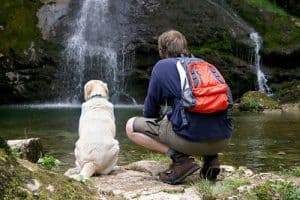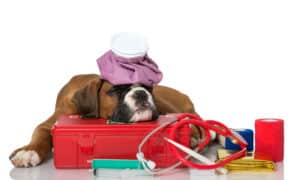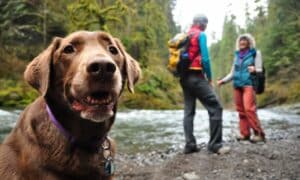“This post contains affiliate links, and I will be compensated if you make a purchase after clicking on my links.”
It’s a beautiful day for an outdoor adventure – and what dog doesn’t love an outdoor adventure? So, strap on your boots, pack up the pooch, and hit the hiking trails! But, before you head out into the wild, it’s important to plan ahead, know your dog’s limitations, and be prepared for whatever may cross your footpath.

In this guide, we’ll cover the basics from planning to packing, to basic first aid, and trail etiquette to ensure that your day ends just as beautifully as it began!
Planning Ahead
Before stepping foot outside with your dog, be sure he’s wearing a collar and identification tag, that vaccines are current, and that he’s protected against fleas, ticks, and parasites. If your dog is microchipped – and this is highly recommended – remember to periodically check that all contact information is accurate and that the registration is up-to-date. It’s always a good idea to discuss your hiking plans with your veterinarian before hitting the trails.
Once you’re confident that your dog is protected and healthy enough for your adventure, begin planning your hike.

Double check with your local parks department, state park, or hiking trail office to be sure that dogs are allowed. Many national parks, for example, do not allow pets on the trails. If dogs are allowed, review the layout, rules, and amenities of the trail you plan to hike. Some trails require dogs to be on fixed leash that is no longer than 6′ in length at all times. Some trails have a maximum of 2 dogs per hiker. Does the trail you plan to hike have water stations or resting areas? Also check for any special alerts and warnings on the day of your hike.
Packing for the Trails

Hydration is absolutely essential for an active, hiking dog. If water is not available at stations along your hike, you’ll need to pack enough to last the entire trip for both you and your dog, then add a little extra in case of delays or unforeseen circumstances.
When you’re sure you’ve packed enough water, add some collapsible food and water dishes, enough food and treats to keep your pup well fed and energetic along your journey, waste disposal bags, appropriate bug repellent, and a small first aid kit.
Remember, when you stop for snacks along the trail, don’t let your dog scarf down a huge meal. It’s both unhealthy and very dangerous to perform rigorous exercise on a full stomach. Instead, dish out small, snack-sized meals more frequently and offer your dog high-protein treats along the hike.

While it seems like a lot to pack, the good news is that your dog can help carry the supplies in a specially designed hiking pack for dogs. Just don’t put too much weight on your dog’s back (young, healthy, experienced hiking dogs can carry about 25% of their body weight in a pack – start your dog with an empty pack at first and work your way up to a heavier pack over a few weeks), and make the sure pack fits properly to avoid chafing or painful irritation, particularly in armpits and on the chest.
Basic First Aid for the Hiking Trail

When hiking, you’ll want to keep your first aid kit as light as possible, but still include the essentials. You should already have a Pet First Aid Kit at home from which you can pull supplies.
Being prepared for an emergency on the trail absolutely vital. Be sure your travel kit includes: sterile gauze, wrapping bandage, scissors, styptic powder, antiseptic, booties, a muzzle, dog-safe electrolyte replacement, liquid capsule antihistamine and a safety pin (explained in detail below), and a book on basic pet first aid. An excellent choice is Field Guide to Dog First Aid: Emergency Care for the Outdoor Dog from Wilderness Adventures Press. This pocket-sized, spiral-bound guide will give you easy instructions for dealing with first aid on the hiking trail. The book covers everything from snake bites to broken bones, heat exhaustion, lacerations, and more.
Look out for signs of dehydration which can quickly lead to heat exhaustion. Symptoms include panting, stumbling, drooling, confusion, or disorientation. If your dog shows any of these signs, immediately take a break and provide plenty of water. The electrolyte replacement from your first aid kit will help him to recover more quickly. To prevent dehydration from occurring, stop for water breaks often and maintain a pace that is comfortable and not too exhausting for your dog.
For minor cuts and scrapes, apply styptic powder to immediately stop the bleeding. For deeper cuts and lacerations, apply antiseptic and cover the wound with sterile gauze. Then use the wrapping bandage to secure the gauze in place.
For broken bones, sprains, or strains to the legs or paws, create a splint using straight, sturdy tree branches or twigs and the wrappable bandage.
In the event of an allergic reaction, bug bites, bee stings, or snake bite, you should always have Benadryl or another antihistamine at the ready.

Here’s a lifesaving tip: Use the liquid capsule type antihistamine in your first aid kit. When hiking, carry along one of the foil packets that the capsules are packaged in, with a safety pin taped to the back. In an emergency, you can quickly administer the lifesaving antihistamine by popping a hole in the capsule with the safety pin and squeezing the liquid center directly into your dog’s mouth. This will both avoid the hassle of trying to give your dog a pill and will allow the medicine to be released into his bloodstream almost instantly. The typical dosage for dogs with allergies is 2mg per pound of body weight (ex: a 40-pound dog would take 80mg every 8 hours) In the event of an emergency – if your dog is bitten by a snake, suffers multiple bee or wasp stings, or has a serious allergic reaction to a poisonous plant, for example – this dosage can usually be doubled. Talk to your vet about the emergency administration of antihistamines for your particular dog.
In the event your dog suffers a cut or burn to his paws, if you’re walking in an area that’s very rocky, if sandspurs are present, or when hiking in extreme weather, he should wear dog boots or booties to prevent injury and/or infection.
And, if your dog suffers a serious injury or is in a great deal of pain, be prepared to muzzle him when help arrives. Even the friendliest, most well-mannered pup can lash out when injured.
Trail Etiquette

Trail etiquette for dogs isn’t much different than the same considerations you take when walking around the neighborhood. Always pick up after your dog. Make sure your dog is always either on a leash or under your complete control at all times. Remember that not everyone is a dog lover, so when you pass other hikers on the trail, make sure your dog doesn’t approach them (unless of course they want her to!). Don’t allow your dog to disturb other hikers, wildlife, or plants along the trail. If your trail of choice is shared with mountain bikers, have your dog step aside and out of the way when they pass through.
Other Tips
- Ease your dog into a hiking routine. If your dog has never hiked before, start with short, easy trails and work your way to longer, all-day adventures and tougher trails.
- If your dog is nervous or fearful of other dogs or strangers, plan to hike trails that are less frequented. Or, plan your hikes for the off-season when the trails are less busy.
- For your dog’s safety, always keep him on a leash, and never let him drink from areas of standing water as these often harbor bacteria and parasites that could be very harmful.
- Keep an eye out for rocky and uneven terrain, debris, broken glass, and other animals, hikers, and mountain bikers at all times.
- When your hike is done, take a few minutes to thoroughly examine your dog for cuts, scrapes, bug bites, and ticks.
- Be sure a close friend or family member is aware of exactly where you’re going and when you plan to be back. You can’t always rely on having cell service, especially in mountains and remote trails. Someone needs to know where to send help if you don’t return when planned.
Do you have any other hiking tips or advice not mentioned above? We’d love your feedback in a comment below.


















